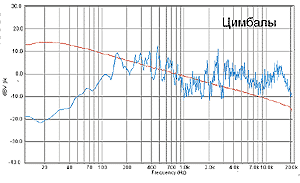Someone James Spry from the California Institute of technology conducted a study on "is There life above 20 kHz?". Well, first of all, he found that there, but now it's not the topic. But along with this he set on some typical, he concluded, phonograms, what is the distribution of on-site power requirements and restrictions, if we measure the AVERAGE and PEAK power of the signal. Indeed, the peak nature of the music is expressed most clearly on top, the most "high-speed" frequencies. That's what brother James did. He took three entries and two crossovers. The records belong to the singer by the name of Diana Krall, the group Talking Heads and our compatriot Dmitry Shostakovich. And crossovers for the experiment were taken three-band, with frequencies of section LF/MF 300 Hz, MF/HF - 3000 Hz or first order (with Butterworth characteristic, there is a different and does not work), or fourth, with the feature of Liquica - Riley. In all cases, the signal strength was measured directly at the terminals of the respective band emitters. Type - it is what it is.
Here is what allocation of capacity for the stripes he received, when it was about average (RMS) capacity:

Pleasure, the science is sound, just the joy of a graduate student. If you use filters with very steep when the speaker gets its specific frequency band, and anything foreign, is obtained directly by curves on the graphs, you already know. Units percent of capacity. When filters with low steepness, of the first order, of course - a little more, but not too God knows how long. At lower frequencies again all for science. The Symphony composers (third column) overworked bass speakers do not give, rockers-popsoviki - flip a job. Note: total percent of capacity not always sum to 100 percent because this is the property of filters with uniform frequency response, where the power is distributed evenly.
Let's see now, what happens if you measure peak power.

Here's to you, and be kind! Anything illegal is not seen Diana Krall when measuring the peak scale showed that the HF-band (above 3 kHz) occasionally have more than 50% power. So accepted and very comfortable for designers of audio school low-power RF channels when multiband amplification of contemporary recordings with great dynamics may fail and will clearly benefit from a critical view. Practical recommendation: the peak power of RF-channel multiband system at a sufficiently low frequency section MF/HF (type 3 kHz, below we no longer happens) you have to choose the same order as the capacity of the MF channel.
Comfortable school low-power RF channels are little adapted to modern recordings with great dynamics.

Range of cymbals kick in. He is much more prevalent than one would assume.
But how far and how vigorously penetrate musical instruments in verniciatura area? Without going into the situation above 20 kHz, where really there, confine ourselves to what is happening in our usual range of sound. For example, academic orchestral cymbals. Who last time at the Conservatory was never, please explain: cymbals are cymbals that musician holds (with loops on the back side of the plates) and the signal conductor of charset them against each other, giving the drama of the execution of the works in accordance with the intent of the author. Cymbals sound, from the viewpoint of the frequency spectrum - like on the chart.
It's funny, of course, that a lot of energy these seemingly very high frequency percussion instruments, focused on medium frequencies up to 200 Hz. The main contribution Satan Snitch in the entire range above 2 kHz, while even at the upper boundary of our field of attention, at 20 kHz amplitude - be kind. And yet, such a tool will be in ANY audio system to play at least two speakers in each channel.
Literature
- The Magazine "Car Audio" No. 11 / 2000
Author: Andrew Elyutin; Publication: www.avtozvuk.com, www.cxem.net






